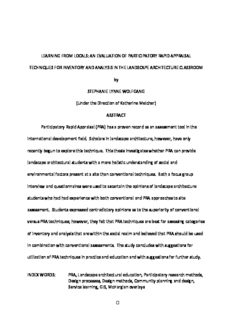
an evaluation of participatory rapid appraisal techniques for inventory and PDF
Preview an evaluation of participatory rapid appraisal techniques for inventory and
LEARNING FROM LOCALS: AN EVALUATION OF PARTICIPATORY RAPID APPRAISAL TECHNIQUES FOR INVENTORY AND ANALYSIS IN THE LANDSCAPE ARCHITECTURE CLASSROOM by STEPHANIE LYNNE WOLFGANG (Under the Direction of Katherine Melcher) ABSTRACT Participatory Rapid Appraisal (PRA) has a proven record as an assessment tool in the international development field. Scholars in landscape architecture, however, have only recently begun to explore this technique. This thesis investigates whether PRA can provide landscape architectural students with a more holistic understanding of social and environmental factors present at a site than conventional techniques. Both a focus group interview and questionnaires were used to ascertain the opinions of landscape architecture students who had had experience with both conventional and PRA approaches to site assessment. Students expressed contradictory opinions as to the superiority of conventional versus PRA techniques; however, they felt that PRA techniques are best for assessing categories of inventory and analysis that are within the social realm and believed that PRA should be used in combination with conventional assessments. The study concludes with suggestions for utilization of PRA techniques in practice and education and with suggestions for further study. INDEX WORDS: PRA, Landscape architectural education, Participatory research methods, Design processes, Design methods, Community planning and design, Service learning, GIS, McHargian overlays LEARNING FROM LOCALS: AN EVALUATION OF PARTICIPATORY RAPID APPRAISAL TECHNIQUES FOR INVENTORY AND ANALYSIS IN THE LANDSCAPE ARCHITECTURE CLASSROOM by STEPHANIE LYNNE WOLFGANG B.S., University of Virginia, 2009 A Thesis Submitted to the Graduate Faculty of The University of Georgia in Partial Fulfillment of the Requirements for the Degree MASTER OF LANDSCAPE ARCHITECTURE ATHENS, GEORGIA 2012 © 2012 Stephanie Lynne Wolfgang All Rights Reserved LEARNING FROM LOCALS: AN EVALUATION OF PARTICIPATORY RAPID APPRAISAL TECHNIQUES FOR INVENTORY AND ANALYSIS IN THE LANDSCAPE ARCHITECTURE CLASSROOM by STEPHANIE LYNNE WOLFGANG Major Professor: Katherine Melcher Committee: Douglas Pardue Stephen Ramos Pratt Cassity Electronic Version Approved: Maureen Grasso Dean of the Graduate School The University of Georgia May 2012 DEDICATION To my family iv ACKNOWLEDGMENTS A great many individuals have contributed to the inception and completion of this thesis. First, I would like to thank my major professor, Katherine Melcher, for her advice, insight, and immense patience. Her astute feedback and guidance have helped this thesis become what it is today and helped me to explore community‐centric design for which we share an interest. I would also like to thank the members of my reading committee, Douglas Pardue, Stephen Ramos, and Pratt Cassity, for taking the time to provide their expert opinions and guide this document through its final stages. I also owe a great deal of gratitude to the individuals who introduced me to PRA and aided in my learning of these methods: the students and faculty of Oxford Brookes University (especially David Sanderson) as well as professionals from SEEDS India and RCPDS. Finally, I would not have been able to complete this thesis without the unwavering support of Donna Gabriel, my classmates (especially those who agreed to be interviewed for this study), my friends, and family. v TABLE OF CONTENTS Page ACKNOWLEDGMENTS....................................................................................................................v LIST OF TABLES............................................................................................................................viii LIST OF FIGURES............................................................................................................................ix CHAPTER 1 INTRODUCTION............................................................................................................1 Context...................................................................................................................1 This Study...............................................................................................................3 Delimitations..........................................................................................................5 2 STUDY METHODOLOGY................................................................................................7 Participants.............................................................................................................7 Study Design.........................................................................................................13 Limitations............................................................................................................16 3 CONVENTIONAL APRROACHES TO INVENTORY AND ANALYSIS.................................18 General Design Processes.....................................................................................18 Generational Processes’ Relationship to Conventional and Participatory Approaches...............................................................................................21 Null‐ and First‐Generation Design Processes in Landscape Architecture.............21 Null‐ and First‐Generation Design Processes in Landscape Education.................31 vi 4 PARTICIPATORY APPROACHES TO INVENTORY AND ANALYSIS..................................34 Advantages of Participation in Design and Planning Processes............................34 Second‐ and Third‐Generation Design Processes in Landscape Architecture......37 Participatory Rapid Appraisal (PRA) .....................................................................46 PRA in Landscape Architecture.............................................................................54 Participatory Design Processes in Landscape Education......................................55 5 STUDY FINDINGS AND ANALYSIS................................................................................60 Focus Group Interview Themes............................................................................60 Questionnaire Results...........................................................................................64 Analysis of Commonalities and Discrepancies in Findings....................................73 6 CONCLUSIONS............................................................................................................75 Implications for Application of PRA......................................................................75 Implications for PRA in Landscape Architectural Curriculum...............................78 Implications for Further Research........................................................................81 REFERENCES ..............................................................................................................................85 APPENDICES A ARCHER’S SYSTEMATIC METHOD FOR DESIGNERS.....................................................91 B INSTRUMENT 1: QUESTIONNAIRES............................................................................92 C INSTRUMENT 2: FOCUS GROUP INTERVIEW GUIDING QUESTIONS ..........................95 D COMPLETED QUESTIONNAIRES..................................................................................97 E FOCUS GROUP INTERVIEW TRANSCRIPT..................................................................108 vii LIST OF TABLES Page Table 1: Summary of null‐ through third‐generation design processes.......................................40 Table 2: Chamber’s rapid rural appraisal‐participatory rural appraisal continuum.....................48 Table 3: Classification of PRA tools by type..................................................................................50 Table 4: Tools used and scored on the questionnaires as listed by student participants............65 Table 5: Experienced effectiveness of conventional tools for landscape site inventory and analysis.............................................................................................................................68 Table 6: Experienced effectiveness of PRA tools for landscape site inventory and analysis........69 Table 7: Effectiveness potential of conventional tools for landscape site inventory and analysis.............................................................................................................................70 Table 8: Effectiveness potential of PRA tools for landscape site inventory and analysis.............71 Table 9: Overlay of all tool rankings.............................................................................................72 Table 10: Comparative evaluation of conventional and PRA approaches....................................73 viii LIST OF FIGURES Page Figure 1: Scattering of grain in the agricultural village of Gramathu Medu...................................9 Figure 2: Beach with fishing boats, shelters, and planted windbreaks in the fishing village of Vizhuntha Mavadi...............................................................................................................9 Figure 3: A community‐drawn map..............................................................................................10 Figure 4: Community venn diagramming.....................................................................................11 Figure 5: Agricultural maps showing post‐tsunami land allocation.............................................11 Figure 6: Null‐generation design processes in landscape architecture........................................22 Figure 7: Greensward Plan for Central Park presentation board.................................................24 Figure 8: First‐generation design processes in landscape architecture.......................................25 Figure 9: Lynch’s diagrams of site analysis...................................................................................27 Figure 10: McHarg’s overlays method for site inventory and analysis.........................................29 Figure 11: Goals of participation in landscape architectural design processes............................36 Figure 12: Second‐generation design processes in landscape architecture.................................37 Figure 13: One of Kroll’s buildings for the Université Catholique de Louvain, Belgium...............38 Figure 14: Third‐generation design processes in landscape architecture....................................39 Figure 15: Arnstein’s ladder of citizen participation....................................................................42 Figure 16: Hester’s 12 steps to community development...........................................................44 Figure 17: Some sources and relatives of RRA and PRA...............................................................47 ix
Description: